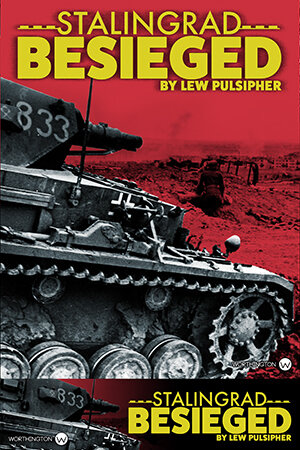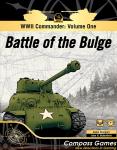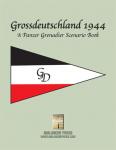![]()
![]()
![]()
![]()
![]()
![]()
Stalingrad Besieged
STALINGRAD BESIEGED is a game that allows 1 to 2 gamers to refight the campaign for Stalingrad in 1942, IN THREE DIFFERENT WAYS; CARDS, BLOCKS, OR COUNTERS. The game plays in 1 hour or less.
The game depicts the battle in the city of Stalingrad itself. This is a street fighter's game, just like the campaign. Intense block to block battles defined the Stalingrad siege and the game reflects this within its design. The game board uses a German map from 1942, with grids defining key locations in the city. The grids are used for movement and combat in the game. Combat is frequent and each side battles back and forth regardless of who moves.
Because of the dynamics of tanks, artillery, and infantry and the variability of the Russian ferry points and the arrival of reinforcements, no two games will play the same. This adds to a great replay value, and to the solitaire play value as well. PLUS, it comes with and allows players to play with the components of their choice; CARDS, LARGE WOODEN BLOCKS, OR OVERSIZED COUNTERS.
Designed by Dr. Lew Pulsipher.
The Battle of Stalingrad was one of the most important battles of World War II. The Axis failed to secure the ferry ports in Stalingrad (cutting off reinforcements) soon enough to prevent the Soviet counterattack that caved in the Axis flanks far from Stalingrad, and ultimately surrounded and captured Stalingrad and the 6th Army. Thereafter, Germany was on the defensive in the war as a whole. This game focuses on action in and around Stalingrad; the Axis must succeed in time to reinforce their flanks against the Soviet November offensive.
Objectives
At the end of the game, if one player controls both Ferry Points, he/she wins. If each player has one, then if the Tank Factory is still intact, Russians win; if it is destroyed, Germans win.
Units
There are 40 units; 16 German and 24 Russian. You get a complete set of units for each component type (cards, blocks, and counters). The numbers reflect many factors; for example, while the Russians may have had better medium tanks at this time, their crews were less well-trained.
Each unit has a designator (for example. German Infantry, Tanks, Anti-Tank Weapons, Artillery, etc ). At the top of the unit is an attack number on the left, a defense number in the center, and a movement capability number on the right, as illustrated.
The top of the unit is its front, the bottom is the rear. The sides are its flanks. Units are unrevealed until they close with the enemy. There are Option cards that can affect play.
Sequence of Play
Both sides follow the below sequence, German player first. During your turn you do the following:
-
(At any appropriate time before combat) play an Option Card
-
Choose replacements (if any)(these may be placed before or during movement)
-
Move some or all your units
-
Conduct combat
-
Draw an Option Card
-
(If Russian) Move turn marker
Reinforcements and Replacements
The battle in Stalingrad was a “meat-grinder”, a battle of attrition more like World War I than World War II. Some destroyed units can be reconstituted, as units were rarely wiped out to a man.
Eliminated units can be reconstituted and rejoin the game as “Replacements”.
Replacements are units returned from the “eliminated pile”. Reinforcements are units that were removed from the deck at the start of the game.
Reinforcements appear only when you play a Reinforcement Option Card.
If a German unit is adjacent to a Ferry point or the Tank Factory, the Russians cannot receive replacements/reinforcements there.
Movement
During your turn you may move all your units. A unit can move one or two areas, but NOT diagonally. Tanks are an exception to this rule. They may move diagonally. This allows them to make breakthroughs as they can slip between enemy units.
Combat
Combat occurs only after all of the units of the player taking their turn have moved.
The opportunity to attack alternates, beginning with the moving player. That player chooses a unit that can attack, and rolls. A cube is placed on the unit to indicate that it has attacked. Then the non-moving player chooses and makes an attack, and places a cube. Then it’s the moving player’s turn. This continues until there are no more possible attacks. Toward the end of the procedure one player may have several attacks in a row because the other has conducted all of their possible attacks. When all attacks have been made, remove the cubes and start the next player’s turn.
Note: making the correct choices is vital. For example, don’t choose one of your units to attack when it can no longer be attacked, instead choose one that might still be attacked. If you can eliminate the potential attacker, you’ve possibly saved a unit.
This explains the basics of the rules. There are additional rules for artillery and air attacks, fortifications, combat modifiers, control of the Ferry Points and Tank factory, tank movement, and anti-tank combat, etc. Solitaire rules are included for game play.
| Publisher | Worthington Publishing |
|---|
 Did you forget your password?
Did you forget your password?





.jpg)






